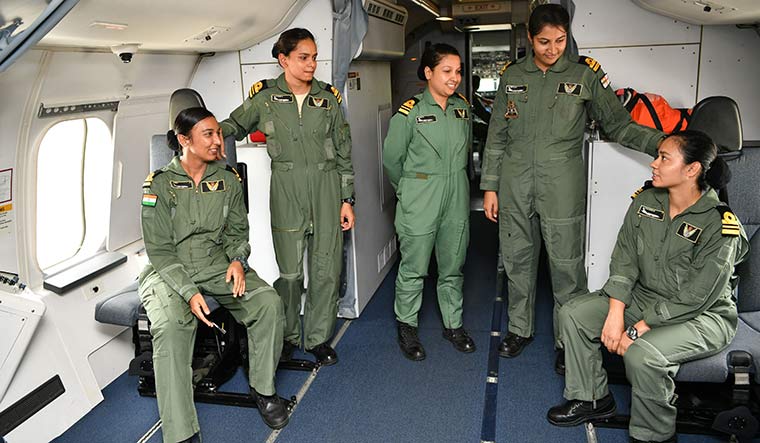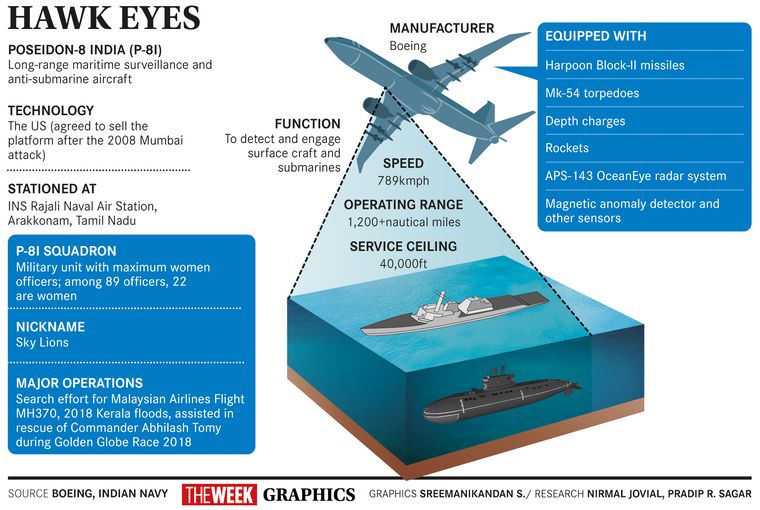LIEUTENANT COMMANDER Ambica Hooda and eight fellow officers swung into action as soon as they received a three-word code on their phones—“fire, fire, fire”. Responding to the call, they assembled in the mission briefing room of INS Rajali naval air station in Arakkonam—and it was just about 6am. The station houses the Indian Naval Air Squadron 312A and India’s most potent asset for aerial reconnaissance—the Poseidon-8I, a variant of the Boeing 737. Arakkonam, some 80km from Chennai, is one of the hottest towns in India, with temperatures going past 43 degrees Celsius regularly.
When THE WEEK visited, however, the temperature had dropped after a good monsoon. Inside the briefing room, Captain Ravi Kumar, the commanding officer of the squadron, called Sky Lions, updated them about the movement of a Chinese landing platform, Dock Xian-32, which was passing through the southern Indian Ocean region, before it entered Sri Lankan waters. Hooda, who has more than 3,400 hours of flying experience, left in a Poseidon-8I, along with Lieutenant Commander Aruna Bhardwaj and Lieutenant Deepa Singh. They were joined by two pilots, two in-flight technicians and two other male officers.
After nearly six hours, Hooda’s team spotted the Dock Xian-32, photographed it and sent the images to naval bases and coastal radar stations for follow-up.
“‘Welcome to the Indian Ocean’. This is the message we usually send whenever we spot a Chinese warship or submarine. In this mission, our task was only to track the Chinese warship,” Hooda told The WEEK. In addition to surveillance gear, the Poseidon-8I is equipped with armaments for anti-submarine warfare and anti-surface warfare.
Hooda is part of the Navy’s ‘women warrior’ team: In 2016, the Navy inducted 22 women aviators to crew the P-8I. The total strength of the team is 89. Aged between 21 and 35, these women Observers monitor sea-search radars and magnetic anomaly detectors to track down submarines and warships.
Captain Kumar, who has been an Observer, says he is proud that the Navy is the first armed force in the country to give female war-fighters equal status.
In the past six years, the squadron has flown from over 30 airfields across the world and has undertaken missions to support all three services.
“If a man can sacrifice his life for the nation, why can’t a woman? I am more than willing to make the supreme sacrifice if required,” says Hooda, who hails from Rohtak, Haryana. “We are just officers. I do not find any particular challenge as a woman in handling all those weapons and sensors. In this squadron, we are just officers.”
The eldest of three siblings, she always dreamt of flying. She joined the Navy after completing her graduation in English literature from Maharshi Dayanand University, Rohtak. “Joining the armed forces had always been my dream. Luckily, I was part of the Navy. I had already flown Dornier aircraft before joining this squadron. After operating [the P-81], I have realised this is one of the best, with sensors and state-of-the-art technology. We usually fly more than nine hours in a sortie and it is a different experience every time.”
Bhardwaj, who has been mission controller on several occasions, said that with a maximum speed of 907kmph and an operating range of over 1,200 nautical miles, the P-8Is could detect threats much before they enter Indian waters. “We maintain an unfettered eye over and under the sea and form the first line of India’s defence at sea,” she said.
The Navy’s first P-8I squadron was set up at INS Rajali in November 2015. “We have eight aircraft and every day some part of the Indian Ocean has to be visited,” said Kumar. “We used to call ourselves the eyes and ears of the Navy. Now we are the eyes, ears and arms of the Navy.”
The squadron proved this in the days following the Pulwama attack. “We played our role to provide cover or intelligence to the ground forces,” said Hooda. The squadron has had a variety of missions, including rescue operations during the 2018 Kerala floods and cyclone Ockhi. “During cyclone Ockhi in Kerala, our aircraft was the first to launch in the extreme weather,” said Lieutenant Commander Priya Chhetri, who is from Dehradun. “We managed to save many lives. It is more satisfactory than finding a Chinese submarine.”
Lieutenant Deepa Singh, who was also part of the mission, said they saved 47 stranded people. Their P-8I was able to direct naval ships, merchant ships and Air Force helicopters. Guided by the P-8I crew, IAF helicopters winched people from the water. Singh, the youngest of the lot, joined in May 2015; this is her first posting. “Initially, my family (in the Churu district of Rajasthan) was hesitant when I told them about me joining the Navy. But joining the offensive platform has now made them proud,” she said. “Most of the time, I do not tell them where I am going for a mission. But when they find that my phone is not reachable, they guess that I am in air.”
Said Lieutenant Commander Tannu Lall, who hails from Odisha: “Times have changed. People do accept woman in combat roles. Being in this squadron gives you a unique identity. You get to know everything happening on the borders, whether it is land or sea. And you get to see the action first hand.”
Her husband is also in the Navy, but posted in Mumbai. “Both of us getting leave together is difficult,” she says. “Though we try to strike a balance between our professional and personal lives.”
Her senior colleague Lieutenant Commander Sapna Dhiman agrees. “Once you are married and have kids, it becomes challenging,” she says. “I cannot leave my one-and-a-half-year-old alone while flying for nine hours and not know what has happened until I land. But, ultimately we are officers by choice.”
And though they might be away from their families, the crew is one big family at the base. “My house has become a preferred choice for get-togethers as there is hardly any hangout place in the town,” she says. “We do enjoy music and gossiping.”
As far as missions go, Deepa says the operation to rescue Commander Abhilash Tomy was the toughest. “It was September 24, 2018,” she says. “We took off from Mauritius at first light. Finding such a small boat was a huge task. During those seven to eight hours of flying, we were continuously hoping for his well-being, as he was transmitting his position regularly to the bases. The sea was terrible. We were praying. It was tense, because we were losing him repeatedly. It was my sortie that transmitted the message to the Australian navy. Luckily, I saw his transfer from the boat to the merchant vessel. The operation took four days and when we saw him safe, it was a big relief.”
The Sky Lions also supported the Balakot airstrike this year. Defence sources said that the P-8I provided intelligence on the Jaish-e-Mohammad terror camp, which helped Air Force jets carry out a precise attack. And, after the attack, the P-8I squadron was on watch on the western border. The P-8Is also shared real-time pictures of Chinese troops during the 2017 Doklam stand-off.
“In the Army, women officers are not allowed in combat roles,” said Bhardwaj. “In the Air Force, the fighter stream has recently opened for women. In the Navy, we Observers are among the first persons to go to war for surveillance.”
For this reason, Bhardwaj and her teammates want a change in their designation. “We have proposed that our designation be changed from Observer to Mission Commander,” she says. “In case of war, Observers will be very much part of it. And when the situation demands, you will be firing the weapons in the aircraft. Every six months, Observers are tested for their firing abilities. And if you fail, you do not get upgraded.”
Adds Lieutenant Commander Sarthak Chauhan, a pilot in the squadron, “We never look at our female colleagues with a difference. They are equally capable and talented. When we are flying, we are only officers.”




